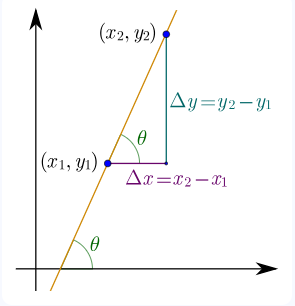1. What is a Multi-Point Slope Calculator?
Definition: This calculator analyzes multiple points to determine the best-fit line using the least squares method. It calculates the slope (m), y-intercept, angle of inclination (θ), percentage grade, total distance, and pairwise distances, Δx, and Δy between consecutive points.
Purpose: It is used in mathematics, engineering, and data analysis to model linear trends and calculate distances along a path defined by multiple points.
2. How Does the Calculator Work?
The calculator uses the least squares method to fit a line to the points and computes additional properties:
Slope (m):
\( m = \frac{n \sum (x_i y_i) - \sum x_i \sum y_i}{n \sum (x_i^2) - (\sum x_i)^2} \)
Y-intercept (b):
\( b = \frac{\sum y_i - m \sum x_i}{n} \)
Angle (θ, degrees):
\( \theta = \arctan(m) \times \frac{180}{\pi} \)
Percentage Grade (%):
\( \text{Percentage Grade} = m \times 100 \)
Distance Between Consecutive Points (d):
\( d = \sqrt{(x_{i+1} - x_i)^2 + (y_{i+1} - y_i)^2} \)
Distance between x's (Δx) and y's (Δy):
\( \Delta x = x_{i+1} - x_i \quad \text{and} \quad \Delta y = y_{i+1} - y_i \)
Total Distance: Sum of distances between consecutive points.
Steps:
- Enter the coordinates of at least two points.
- Add or remove points as needed using the buttons.
- Validate the inputs to ensure at least two points and no vertical line (all x values equal).
- Fit a line using the least squares method to calculate slope and y-intercept.
- Compute the angle, percentage grade, and distances using the formulas above.
- Display the results with appropriate precision (4 decimal places for angle, percentage grade, and distances).
3. Importance of Multi-Point Slope Calculation
Multi-point slope calculations are essential for:
- Data Analysis: Fitting a trend line to scattered data points.
- Engineering: Designing paths or trajectories with multiple waypoints.
- Surveying: Calculating distances and slopes across multiple survey points.
4. Using the Calculator
Example 1: Calculate the properties for points (0, 0), (1, 1), and (2, 2):
- Points: (0, 0), (1, 1), (2, 2)
- Least Squares Fit: Perfect line, Slope \( m = 1 \), Y-intercept \( b = 0 \)
- Angle: \( \theta = \arctan(1) \times \frac{180}{\pi} = 45.0000^\circ \)
- Percentage Grade: \( 1 \times 100 = 100.0000\% \)
- Point 1 to Point 2: Distance \( \sqrt{(1-0)^2 + (1-0)^2} = 1.4142 \), Δx = 1, Δy = 1
- Point 2 to Point 3: Distance \( \sqrt{(2-1)^2 + (2-1)^2} = 1.4142 \), Δx = 1, Δy = 1
- Total Distance: \( 1.4142 + 1.4142 = 2.8284 \)
Example 2: Calculate the properties for points (1, 2), (3, 4), (5, 5):
- Points: (1, 2), (3, 4), (5, 5)
- Least Squares Fit: Slope \( m \approx 0.65 \), Y-intercept \( b \approx 1.45 \)
- Angle: \( \theta = \arctan(0.65) \times \frac{180}{\pi} \approx 33.0243^\circ \)
- Percentage Grade: \( 0.65 \times 100 \approx 65.0000\% \)
- Point 1 to Point 2: Distance \( \sqrt{(3-1)^2 + (4-2)^2} = 2.8284 \), Δx = 2, Δy = 2
- Point 2 to Point 3: Distance \( \sqrt{(5-3)^2 + (5-4)^2} = 2.2361 \), Δx = 2, Δy = 1
- Total Distance: \( 2.8284 + 2.2361 = 5.0645 \)
5. Frequently Asked Questions (FAQ)
Q: Why use least squares for multiple points?
A: Least squares minimizes the error between the points and the fitted line, providing the best linear approximation.
Q: What happens if all x values are the same?
A: The slope becomes undefined (vertical line), and the calculator will display an error message.
Q: Can I calculate distances for non-consecutive points?
A: This calculator computes distances between consecutive points. For non-consecutive distances, you can calculate each pair separately.
Multi-Point Slope Calculator© - All Rights Reserved 2025
 Home
Home
 Back
Back
